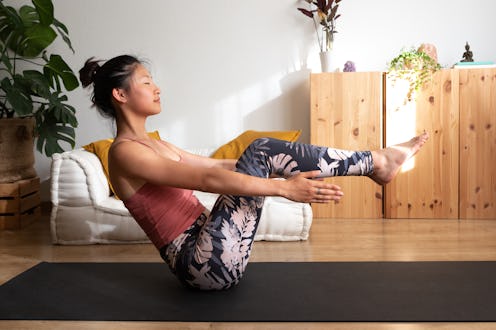Fitness
Boat Pose Is The Yoga Move That Lights Up Your Entire Core
It’s an exercise and a stretch.

If you’re looking for a yoga move that doubles as both an exercise and a stretch, plop down onto your mat and give boat pose a try. This multi-purpose posture not only works your abs, but it’s also an ideal way to loosen up tight hips and shoulders while improving your overall stability.
Boat pose, or navasana, is a seated yoga posture that has you balance on your tailbone while you lift your feet off the ground, says Stella Stephanopoulos, a yoga teacher at Equinox and CorePower Yoga. Depending on how you do the pose, it can be slightly tricky or full-on challenging, which makes it great for all levels.
According to Anna Rillahan, an RYT-500 yoga teacher, boat pose is an effective way to strengthen your core muscles. As you lean back and lift your toes, you’ll light up your rectus abdominis, transverse abdominis, and even your obliques. “By engaging these muscles, you'll build a solid foundation for other yoga poses and everyday activities,” she tells Bustle. And because boat pose requires you to find your center of gravity, it’s a good one for improving your overall stability.
The angles in this posture also provide a nice stretch for your spine, as well as your shoulders and hip flexors, aka the muscles that bring your legs inward. “By sitting tall and elongating your torso, you promote better posture and alignment, which can alleviate back pain and discomfort, too,” Rillahan adds.
Think of this exercise as a one-stop shop that offers multiple benefits. Below, yoga instructors explain how to do boat pose, as well as how to modify the move.
How To Do Boat Pose
Here, Stephanopoulos explains how to do boat pose using good form.
- Start in a seated position with your feet flat on the floor and your knees bent.
- Engage your core as you slowly lean back on your sits bone.
- Bring your spine to a 45-degree angle.
- When you feel steady, lift one foot off the mat and then the other.
- Lift your legs until your shins are parallel to the floor.
- Flex your feet and hold this position.
- If you can, bring your arms overhead and spread your fingertips wide.
- Lower your shoulders away from your ears.
- Hold for three to five breaths.
How To Modify Boat Pose
To enter the full expression of boat pose, straighten your legs and lift your feet up to create a 45-degree angle as you balance on your booty. Your core muscles will engage as they work to keep you steady — and you’ll have to breathe deeper to stay comfy in the pose, Stephanopoulos says.
You can also take things up a notch by adding a yoga block between your thighs for an additional element that’ll activate more of your muscles. “If you don’t have a block handy, you can simply move your arms overhead alongside your ears to increase the load on your core,” Rillahan says.
If that’s too challenging, go easy by keeping your knees bent or by resting both of your feet on the floor as you lean backward. According to Stephanopoulos, the lean will still activate your core just the same, especially if you make an effort to keep your back as straight as possible.
If you’re trying boat pose for the first time, it might feel good to lift one foot off the ground at a time. “Find balance and stability before attempting to lift both feet simultaneously,” Rillahan adds. “You can also hold your hands behind your knees to help stabilize as you lift your feet up.”
Common Boat Pose Mistakes
Keep in mind, you don’t have to stick your legs up in the air to reap all of the benefits of boat pose. In fact, Stephanopoulos says straightening your legs before you’ve developed a strong core could put unwanted pressure on your lower back — so definitely give yourself plenty of time to build up to that level.
Your main goal in boat pose is to keep your back straight the entire time, even though you’ll want to round inwards. “Think about how you can create length in your spine while you keep a tight ‘V’ shape between your thighs and torso,” she says. “This will allow you to strengthen your core more effectively, and eventually it will be easier to straighten your legs and balance.”
As you get into the pose, it’s also important to make sure your chest stays open and lifted. “This will help you maintain proper alignment and ensures an effective engagement of your core,” Rillahan says. Staying straight will also prevent you from holding your breath, which can be super tempting when your muscles are under tension.
For the finishing touch, pay attention to your neck. Rillahan suggests looking straight ahead so you don’t twist or strain your neck muscles by looking up or down. When done in perfect form, you’ll be able to reap all the core-strengthening benefits of the move.
Studies referenced:
Tekur, P. (2010). Effect of yoga on quality of life of CLBP patients: A randomized control study. Int J Yoga. doi: 10.4103/0973-6131.66773.
Sources:
Anna Rillahan, RYT-500 yoga teacher
Stella Stephanopoulos, yoga teacher at Equinox and CorePower Yoga